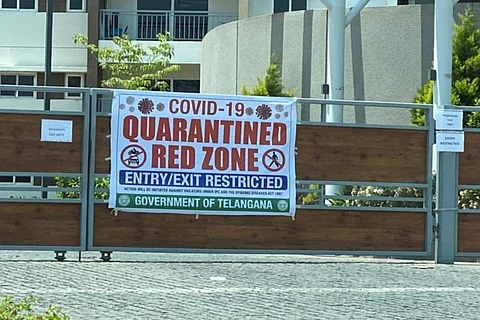

There are no more containment zones in Hyderabad, only hotspots, say Greater Hyderabad Municipal Corporation (GHMC) officials. The strategy of cordoning off an area and restricting movement in and out of the locality was first adopted in April 2020, with the aim to contain the spread of COVID-19. However, a year later, even as COVID-19 cases surge across the city and the state, this strategy appears to have been ditched by the Municipal Administration and Urban Development Department (MAUD).
Health officials attached to the GHMC tell TNM that their present strategy to contain COVID-19 includes identifying hot spots – localities with high population density, such as gated communities and slums. The officials, however, say they aren’t declaring any areas as containment zones. But they are requesting locals to voluntarily restrict movement in and out of such hotspots and urging them to follow physical distancing norms.
“Actual containment zone is not there, but in some places we are restricting movement by giving instructions to people to stay at home,” said Dr Srujana, Deputy Director of Medical Health Office (DMHO) for Serilingampally circle. The official said they had carried out fever surveys and then identified hotspots in several gated communities and slums within their circle.
“It’s everywhere, it’s rampant. There are no containment zones but hotspots,” said Dr KS Ravi, the Assistant Medical Officer for Health (AMOH) with GHMC, under whose jurisdiction a gated community reported 121 positive COVID-19 cases. “For gated communities, we’re telling them to not allow outsiders. They should strictly not allow strangers to enter. Play areas and clubhouses are to be restricted. The entry of milk suppliers, vegetable supplies and maids is also not allowed,” he added.
Officials say they are carrying out Rapid Antigen Tests among domestic workers who are employed at these gated communities and at the slums where they reside.
Both officials said there aren’t any localities in their circle termed as containment zones.
SQ Masood, a social activist, however pointed out that the GHMC’s decision to not mark containment zones is in violation of several government orders issued by the Telangana government. The activist points towards the Government Orders issued on October 7, November 16 and November 23, 2020.
All the three GOs are related to the reopening of cinemas, permitting of functions and congregations in limited numbers. All these activities are to be carried out outside containment zones, according to the GO. “The whole concept of a containment zone is gone, now there are none,” said the activist.
Representatives of resident welfare associations are also of the view that a year into the pandemic, proactive efforts by the GHMC in identifying and enforcing containment zones or undertaking contact tracing efforts have weakened.
“The Telangana government is giving day to day details on cases and asking people to stay at home or wear a mask when outside,” said BT Srinivas, General Secretary of United Federation of Resident Welfare Associations (UFERWAS). “Apart from these instructions, there is nothing else now. In the beginning, GHMC monitored everything, they did contact tracing, were proactive in giving information, and they used to come to sanitise, educate people. Now they must be thinking people know it all and there is no need to repeat the message,” he added.
The idea of cordoning off localities and terming containment zones was a strategy first adopted in April, a month into the COVID-19 pandemic in 2020.
The corporation at the time had restricted the movement of people in and out of such localities by placing barricades at all exit and entry points. All essentials required by households in a containment zone were also arranged by the corporation. All shops and establishments within a containment zone used to remain shut, except for medical stores.
The public within these zones were to be monitored and helped by a nodal officer, police officer, representatives from the medical and health department, assistant medical officer of the health and entomology department and a bill collector.
“The aim of these containment zones was to curtail further events and keep the spread of the disease in check. But now people who get tested positive are given medicines at the PHC level and asked to stay at home. No efforts are being made to even check if the family of the person who tested positive is at risk of contracting the infection,” alleged Masood.
Officials, however, refute this and say they are doing their best with assistance from Asha workers and ANMs to educate the public.
“We have to do something to break the chain, restricting the mobility of gated communities is one solution. We’re going there and educating them, testing them, giving isolation kits and undertaking sanitation work. But our biggest challenge is restricting the mobility of people, nobody wants to stay at home. Some people don’t want to get tested, they are scared they will face stigma if they test positive,” Dr Srujana said.